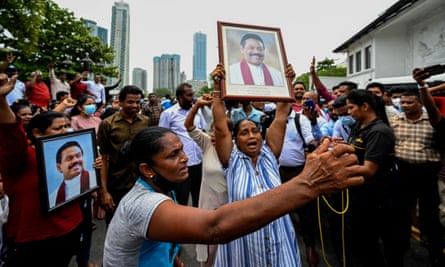Sri Lankan troops have conducted a dramatic pre-dawn operation to rescue Mahinda Rajapaksa – who resigned as prime minister on Monday – firing warning shots in the air to disperse thousands of anti-government protesters who had stormed his official residence in Colombo.
Eight people have been killed and over 200 wounded after pro-government supporters provoked violence among previously peaceful protests, which have been taking place for weeks in the midst of an unprecedented economic crisis.
On Tuesday, in a move that could lead to further bloodshed, the defence ministry said security forces had now “been ordered to shoot on sight anyone looting public property or causing harm to life”.
Earlier, demonstrations had continued as hundreds of anti-government protesters defied a nationwide curfew, gathering in the streets of Colombo and shouting slogans outside the office of the president, Gotabaya Rajapaksa.
Mahinda Rajapaksa, the president’s brother, had reluctantly stepped down in a bid to placate the protesters who have accused the government of mishandling the economy and bankrupting the country, but his resignation did little to calm public anger.
Late on Monday night, protesters tried forced their way into Temple Trees, the prime minister’s official residence, and attempted to storm the main two-storey building where Mahinda Rajapaksa was holed up with his family.
“After a pre-dawn operation, the former PM and his family were evacuated to safety by the army,” said a security official. “At least 10 petrol bombs were thrown into the compound.”
Mahinda Rajapaksa’s removal to an undisclosed location followed a day of violent protests, with the homes of more than 40 pro-Rajapaksa politicians set on fire. Burned-out cars and buses littered the streets of Colombo on Tuesday.
On Tuesday police kept up a barrage of teargas and fired warning shots in the air to hold back protesters at all three entrances to Temple Trees, where anti-government demonstrations have been taking place for weeks.
The president declared a state of emergency over the weekend, giving sweeping powers of arrest to the military, as protests demanding his resignation escalated.
Protesters and Sri Lankan religious leaders have blamed Rajapaksa supporters for turning the protests, which had been largely peaceful, into scenes of violence, which then spread across the country.
Pro-Rajapaksa supporters, many bussed in from outside the city and armed with iron rods and sticks, violently attacked an anti-government protest site in Colombo on Monday, leaving almost 200 people injured. In two other separate incidents, politicians from the ruling party opened fire on anti-government protesters, killing three people and injuring at least five.
Protesters gathered around the airports and set up checkpoints to make sure that none of the politicians from the ruling party attempted to flee Sri Lanka. Namal Rajapaksa, a son of the resigned prime minister, said the family had no intention of leaving.
Gotabaya Rajapaksa urged people to “remain calm and stop violence and acts of revenge against citizens, irrespective of political affiliations”.
“All efforts will be made to restore political stability through consensus, within constitutional mandate and to resolve economic crisis,” the president said in a tweet.
The UN condemned the violence, with its high commissioner for human rights, Michelle Bachelet, calling on the authorities to prevent further unrest. “I am deeply troubled by the escalation of violence in Sri Lanka after supporters of the prime minister attacked peaceful protesters in Colombo yesterday, 9 May, and the subsequent mob violence against members of the ruling party,” Bachelet said on Tuesday.

Sri Lanka’s deepening economic crisis is the worst since independence in 1948, with its foreign reserves falling to record lows. The government has been unable to import food, fuel and medicines, leading to shortages of essentials, lengthy power cuts and fears of starvation.
Protesters have been calling for both members of Sri Lanka’s powerful Rajapaksa political dynasty to be removed from office, accusing them of financial impropriety and corruption, but Gotabaya Rajapaksa has repeatedly said he will not resign as president.
His brother’s resignation appeared to be an attempt to appease protesters, but the scenes in Colombo on Tuesday made it clear that many would not be satisfied until Gotabaya had also stepped down.
The Rajapaksas have largely controlled Sri Lankan politics for two decades, but the economic crisis has challenged their grip on power in the face of mass unrest from people who had previously supported their brand of nationalist politics, which pandered to the Sinhalese Buddhist majority.
With Mahinda Rajapaksa no longer prime minister, Sri Lanka’s government has been dissolved. While the president has declared he intends to form a “unity cabinet” with members of all political parties, the main opposition party stated that it would not help form a government until the president stepped down.